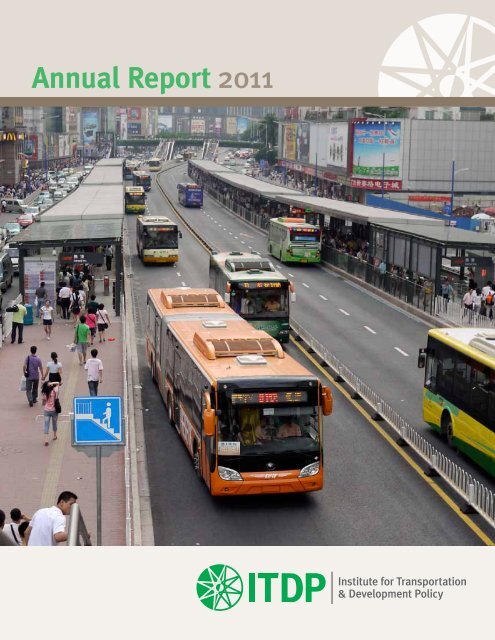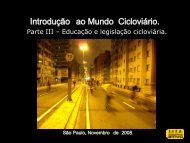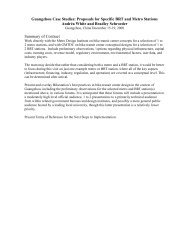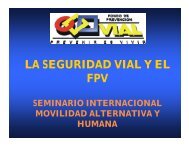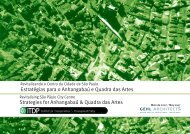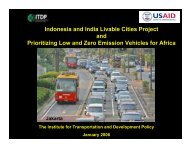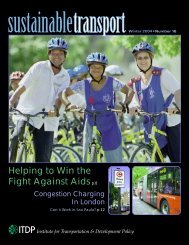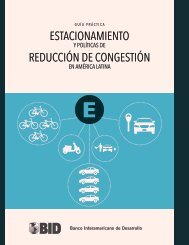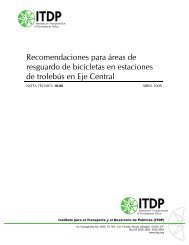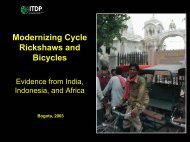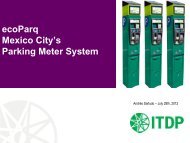Annual Report - ITDP | Institute for Transportation and Development ...
Annual Report - ITDP | Institute for Transportation and Development ...
Annual Report - ITDP | Institute for Transportation and Development ...
Create successful ePaper yourself
Turn your PDF publications into a flip-book with our unique Google optimized e-Paper software.
<strong>Annual</strong> <strong>Report</strong> 2011
<strong>ITDP</strong> <strong>Annual</strong> <strong>Report</strong> 2011<br />
Mission 3<br />
Letter from the Executive Director 4<br />
Why Transport Matters 6<br />
Key Achievments in 2011 8<br />
Program Updates 10<br />
Supporters 17<br />
Financial In<strong>for</strong>mation 18<br />
Board <strong>and</strong> Staff 24<br />
2 | <strong>Institute</strong> <strong>for</strong> <strong>Transportation</strong> & <strong>Development</strong> Policy
Mission<br />
Founded in 1985, the <strong>Institute</strong> <strong>for</strong> <strong>Transportation</strong> <strong>and</strong><br />
<strong>Development</strong> Policy (<strong>ITDP</strong>) is a leading organization in the<br />
promotion of sustainable <strong>and</strong> equitable transportation<br />
policies <strong>and</strong> projects worldwide. <strong>ITDP</strong> is at the <strong>for</strong>efront of<br />
ef<strong>for</strong>ts to reduce carbon emissions, protect the environment,<br />
enhance economic opportunity, <strong>and</strong> improve the<br />
quality of urban life.<br />
By providing technical transport <strong>and</strong> planning expertise<br />
to local authorities, <strong>ITDP</strong> helps cities to: build bus<br />
rapid transit (BRT) systems, develop high quality cycling<br />
<strong>and</strong> walking facilities, manage traffic dem<strong>and</strong>, <strong>and</strong> promote<br />
pedestrian <strong>and</strong> transit-oriented development.<br />
<strong>ITDP</strong>’s work also extends to guiding transport <strong>and</strong><br />
climate policy at all levels of government. Every <strong>ITDP</strong><br />
project builds local knowledge <strong>and</strong> skills while generating<br />
greater public awareness of viable sustainable transport<br />
solutions. In addition, completed projects serve as demonstrations—inspiring<br />
other cities towards more environmentally<br />
<strong>and</strong> people-friendly transportation.<br />
<strong>ITDP</strong> has offices in Argentina, Brazil, China, Hungary,<br />
India, Indonesia, Mexico, <strong>and</strong> the United States; employs<br />
more than 80 staff members; <strong>and</strong> supplements this<br />
team with leading architects, urban planners, transport<br />
experts, developers, <strong>and</strong> financiers.<br />
2011 <strong>Annual</strong> <strong>Report</strong> | 3
Letter from the Executive Director<br />
By Walter Hook<br />
2011, perhaps more than any other time<br />
in <strong>ITDP</strong>’s history, has seen momentum <strong>for</strong><br />
positive change building significantly. Our<br />
past work is bearing real fruit, <strong>and</strong> the<br />
impact is exponential. Dem<strong>and</strong> among cities<br />
around the world <strong>for</strong> <strong>ITDP</strong>’s involvement<br />
<strong>and</strong> expertise is higher than ever.<br />
In every city where <strong>ITDP</strong> works, we aim<br />
<strong>for</strong> trans<strong>for</strong>mative change that will inspire<br />
<strong>and</strong> capture the imagination of other city<br />
leaders <strong>and</strong> residents <strong>and</strong> encourage them<br />
to follow suit. As a result of this approach,<br />
<strong>ITDP</strong> has achieved several successful transport<br />
projects in just the past few years that<br />
we are able to use as models to inspire other<br />
cities to change <strong>for</strong> the better. The time is<br />
now to put in place safe, sustainable transport<br />
infrastructure <strong>and</strong> systems that will<br />
enable cities to cope with rapid influxes of<br />
residents, while also avoiding a boom in car<br />
use. If we don’t act, the world will see more<br />
deadly pollution <strong>and</strong> catastrophic emissions.<br />
Recent reports predict that China is on<br />
course to exceed <strong>for</strong>ecasts <strong>for</strong> greenhouse<br />
gas emissions because its economy is growing<br />
faster than expected <strong>and</strong> becoming<br />
“locked in” to carbon-intensive activities.<br />
The UN now estimates that 231 million<br />
people will be added to Chinese cities by<br />
2025 <strong>and</strong> another 186 million by 2050 —<br />
roughly equal to the populations of Indonesia<br />
<strong>and</strong> Brazil, respectively. To prepare <strong>for</strong><br />
this growth, Chinese leaders are planning<br />
<strong>and</strong> building at least 1,000 br<strong>and</strong>-new cit-<br />
4 | <strong>Institute</strong> <strong>for</strong> <strong>Transportation</strong> & <strong>Development</strong> Policy
ies. In India, the UN projects that cities will<br />
gain 167 million people by 2025 <strong>and</strong> absorb<br />
an additional 352 million residents by 2050.<br />
India’s urban expansion will require the<br />
construction of 700 million to 900 million<br />
square meters of residential <strong>and</strong> commercial<br />
space per year — equivalent to building two<br />
new Mumbais or another Chicago each year.<br />
It can seem overwhelming, but progress<br />
is being made. <strong>ITDP</strong> has been working in<br />
Ahmedabad, India, a city of six million, since<br />
2004. We were able to bring about India’s<br />
first world-class bus rapid transit (BRT)<br />
system in Ahmedabad in 2009, a result of<br />
years of work with the city. First, to convince<br />
them that a BRT was a smarter investment<br />
in transport than roads or expensive alternatives,<br />
<strong>and</strong> then to help guide city decisionmakers<br />
to ensure that the BRT system was<br />
top notch rather than just some minor<br />
modifications to the city’s chaotic buses.<br />
<strong>ITDP</strong> was also instrumental in pushing the<br />
city to build to new bike lanes <strong>and</strong> safer<br />
pedestrian spaces.<br />
Since these changes went into effect, several<br />
other Indian cities, including Chennai,<br />
Surat, Rajkot, <strong>and</strong> Pimpri-Chinchwad, have<br />
followed Ahmedabad’s lead <strong>and</strong> are now<br />
pursuing their own BRT, cycling, <strong>and</strong> pedestrian<br />
projects that promise to at least meet<br />
the bar set by Ahmedabad. <strong>ITDP</strong> remains<br />
actively involved in to help ensure that their<br />
projects deliver both social <strong>and</strong> environmental<br />
benefits to city residents <strong>and</strong> the planet.<br />
In China, we are experiencing the same<br />
positive momentum <strong>for</strong> change. Last year,<br />
after several years of <strong>ITDP</strong>’s advocacy <strong>and</strong><br />
technical work, Guangzhou opened an<br />
extraordinary BRT system, complete with<br />
bike lanes, bike share, <strong>and</strong> greenways along<br />
the route. Like Ahmedabad, Guangzhou is<br />
inspiring high quality replication in cities<br />
throughout the country. Cities like Lanzhou<br />
<strong>and</strong> Yichang that previously had not considered<br />
public transit or bike share are now<br />
taking up sustainable transport projects<br />
with fervor after witnessing the runaway<br />
success of Guangzhou. Fortunately, we’ve<br />
been able to be there at critical moments to<br />
shape these cities transport plans.<br />
Poor transport decisions <strong>and</strong> projects<br />
have long lifetimes. Once a highway is<br />
constructed or once a new car-dependent<br />
neighborhood is built, a city is <strong>for</strong>ever<br />
changed <strong>and</strong> the negative effects will haunt<br />
us <strong>for</strong> generations. <strong>ITDP</strong> continues to work<br />
tirelessly in cities around the world to help<br />
guide their development in ways that are<br />
sustainable <strong>and</strong> equitable.<br />
Thank you,<br />
Dr. Walter Hook, PhD<br />
Chief Executive Officer<br />
2011 <strong>Annual</strong> <strong>Report</strong> | 5
WHY TRANSPORT MATTERS<br />
<strong>Transportation</strong> is at the heart of many of the most pressing issues facing the world today.<br />
Transport networks are the pulse of a city, defining livability <strong>and</strong> urban space.<br />
Air Pollution<br />
Air pollution comes from many different sources such as factories <strong>and</strong> power plants,<br />
but one of the largest sources is from motor vehicles. Urban air quality is one of the world’s<br />
worst pollution problems. <strong>ITDP</strong> promotes sustainable transportation alternatives, like<br />
cycling, walking, <strong>and</strong> mass transit, which remove motor vehicles from the road <strong>and</strong> reduces<br />
pollution levels.<br />
Climate Change<br />
The transportation sector is an enormous contributor of CO 2<br />
<strong>and</strong> greenhouse gas emissions.<br />
Sustainable transportation planning <strong>and</strong> policy is crucial in reducing emissions <strong>and</strong><br />
avoiding catastrophic global warming. <strong>ITDP</strong> works at all scales - municipal, national, <strong>and</strong><br />
international – to initiate <strong>and</strong> support action toward more sustainable transportation, urban<br />
planning <strong>and</strong> design, <strong>and</strong> policy.<br />
Health<br />
<strong>Transportation</strong> impacts health in various ways relating to air pollution, sedentary lifestyle<br />
<strong>and</strong> obesity, quality of life, <strong>and</strong> access to care. <strong>ITDP</strong> promotes healthy <strong>and</strong> sustainable<br />
transportation alternatives, like cycling <strong>and</strong> walking, which helps mediate the negative<br />
effects of car transport on health. <strong>ITDP</strong> also works to improve mobility, which increases<br />
access to health care particularly among the poor.<br />
Poverty Alleviation<br />
One key aspect of poverty alleviation is working to increase mobility <strong>for</strong> all residents.<br />
Access to safe <strong>and</strong> af<strong>for</strong>dable transportation enables greater economic opportunities <strong>and</strong><br />
quality of life. Inadequate mobility prevents people from being able to work, access health<br />
care, get quality nutrition, or accomplish other daily tasks we all take <strong>for</strong> granted. <strong>ITDP</strong><br />
works to redesign <strong>and</strong> implement policies that take into account the transportation needs<br />
of those living in poverty, including generating local employment through the transport sector,<br />
<strong>and</strong> the strategic use of transport to reduce regional disparities.<br />
6 | <strong>Institute</strong> <strong>for</strong> <strong>Transportation</strong> & <strong>Development</strong> Policy
Road Safety<br />
Road accidents cause staggering numbers of deaths <strong>and</strong> injuries, especially in the developing<br />
world. Most of those affected are pedestrians <strong>and</strong> cyclists in incidents that could be<br />
avoided with improved planning <strong>and</strong> policy. <strong>ITDP</strong> encourages cities to design infrastructure<br />
with the protection of cyclists <strong>and</strong> pedestrians in mind, while enhancing public transport<br />
<strong>and</strong> improving the behavior of motorists.<br />
Urbanization<br />
The proportion of the world population living in cities is increasing at an unprecedented<br />
rate. By 2030, five billion people will live in cities, <strong>and</strong> 95 percent of that growth will occur<br />
in Asia <strong>and</strong> Africa, much of which is underdeveloped. In order to avoid crippling congestion<br />
<strong>and</strong> emissions, cities must adapt with sustainable transportation <strong>and</strong> integrated urban planning.<br />
<strong>ITDP</strong> works with the political <strong>and</strong> economic leaders of the world’s major cities to make<br />
in<strong>for</strong>med decisions <strong>and</strong> take appropriate steps towards trans<strong>for</strong>mative urban design <strong>and</strong><br />
transit-oriented development.<br />
2011 <strong>Annual</strong> <strong>Report</strong> | 7
Key Achievements in 2011<br />
In 2011, <strong>ITDP</strong> realized our goal of getting a worldclass<br />
Bus Rapid Transit (BRT) system in each region<br />
where we work, including those systems in Ahmedabad,<br />
Bogotá, Guangzhou, Jakarta, Johannesburg,<br />
<strong>and</strong> Mexico City. These systems continue to impress<br />
political leaders <strong>and</strong> inspire replication in other cities.<br />
The good will generated by successful BRT projects<br />
helped us convince policy-makers in key municipalities<br />
to introduce bike lanes, pedestrian zones, greenways,<br />
bike sharing, <strong>and</strong> other measures that shifted<br />
a growing number of trips away from private cars. In<br />
addition, <strong>ITDP</strong>’s research <strong>and</strong> documentation of best<br />
practices has led to the successful implementation<br />
of BRT systems in other cities with only supporting<br />
involvement from <strong>ITDP</strong>.<br />
With ever-increasing momentum driving the scale<br />
Commuters board bus rapid transit in Cape<br />
Town, South Africa (left), <strong>and</strong> Ahmedabad,<br />
India (right). Bottom: Cyclists take advantage<br />
of Medellin, Colombia’s successful <strong>and</strong><br />
growing bike share system, EnCicla.<br />
8 | <strong>Institute</strong> <strong>for</strong> <strong>Transportation</strong> & <strong>Development</strong> Policy
up of BRT, in 2011 <strong>ITDP</strong> laid the foundation <strong>for</strong> a<br />
robust urban development program that aims to<br />
marry our extensive portfolio of transport work with<br />
urban design <strong>and</strong> development that leverages the CO 2<br />
emissions savings of these transport systems. With<br />
over 250 million Indians <strong>and</strong> 300 million Chinese moving<br />
into cities over the next two decades, we brought<br />
our urban development program, Our Cities Ourselves<br />
(OCO), to Ahmedabad <strong>and</strong> Guangzhou to promote<br />
not only BRT, but also our new ‘OCO Principles <strong>for</strong><br />
Transport in Urban Life’ (developed jointly with Gehl<br />
Architects <strong>and</strong> CSEP). <strong>ITDP</strong> is now working with city<br />
leaders <strong>and</strong> developers to push <strong>for</strong> new, transit oriented<br />
urban designs <strong>and</strong> regulatory changes – particularly<br />
in parking re<strong>for</strong>m – that can significantly reduce<br />
car dependency <strong>and</strong> yield massive CO 2<br />
reductions.<br />
Images from <strong>ITDP</strong>’s Our Cities, Ourselves exhibitions in<br />
India <strong>and</strong> New York City.<br />
Below right: New York City Department of <strong>Transportation</strong><br />
Commissioner Janette Sadik-Khan <strong>and</strong> Chair of the City<br />
Planning Commission meet with <strong>ITDP</strong> India Country Director<br />
Shreya Gadepalli, <strong>and</strong> senior transport officials in Chennai.<br />
2011 <strong>Annual</strong> <strong>Report</strong> | 9
PUBLIC TRANSPORT<br />
<strong>ITDP</strong> completed a report on CO2 emissions<br />
reductions resulting from China’s Guangzhou<br />
BRT, which showed that Guangzhou’s BRT<br />
will reduce more emissions than any other<br />
BRT system in the world, an average of 86,000<br />
tonnes of CO2 per year over its first ten years<br />
of operations, <strong>for</strong> a yearly CER value of 19<br />
million yuan. The impact of the BRT system<br />
goes beyond emissions reductions in Guangzhou.<br />
The system is serving as a model <strong>for</strong><br />
the rest of Asia by demonstrating the viability<br />
of metro-scale BRT <strong>and</strong> the potential costeffectiveness<br />
of urban transport.<br />
In 2011, the Guangzhou system won the<br />
Guangzhou City best planning project <strong>for</strong><br />
2010, <strong>and</strong> the Guangdong Provincial Best<br />
Design Level 1 Prize <strong>for</strong> 2010. It was the front<br />
page feature of a major Urban L<strong>and</strong> <strong>Institute</strong><br />
<strong>and</strong> Ernst & Young annual report, Infrastructure<br />
2011, targeted at policy-makers <strong>and</strong><br />
development-related stakeholders around<br />
the world, as well as the front page feature<br />
in the latest edition of Urban Transport of<br />
China, the most influential transport journal<br />
in China. The Guangzhou BRT system has<br />
already directly influenced several other<br />
Chinese cities to initiate BRT project planning,<br />
including (but not limited to) Changsha,<br />
Wuhan, Harbin, Shenzhen, Jiangmen,<br />
Yichang, <strong>and</strong> Fuzhou, with at least two visiting<br />
delegations from other Chinese cities per<br />
week. Cities with existing BRT systems are<br />
being influenced by Guangzhou, as well as<br />
international cities such as Jakarta. In 2011,<br />
<strong>ITDP</strong> also continued to provide technical<br />
assistance to the city of Lanzhou, whose BRT<br />
is under construction <strong>and</strong> is due to open in<br />
early 2012.<br />
One of the biggest successes <strong>for</strong> the year<br />
<strong>for</strong> <strong>ITDP</strong> was the opening of the first BRT<br />
in Argentina on May 31, 2011. Metrobús<br />
runs along Avenue Juan B. Justo in Buenos<br />
Aires, <strong>and</strong> its 21 stations are served by both<br />
articulated <strong>and</strong> st<strong>and</strong>ard length buses. The<br />
system includes other st<strong>and</strong>ard features of<br />
BRT, including physically separated lanes<br />
that run in the middle of the street, elevated<br />
station plat<strong>for</strong>ms <strong>and</strong> countdown clocks.<br />
The city expects the line to draw additional<br />
ridership as people adjust to the new system,<br />
growing to an anticipated 100,000 daily<br />
riders. Expansion of the system is ongoing<br />
<strong>and</strong> will be a focus of <strong>ITDP</strong>’s ef<strong>for</strong>ts in 2012.<br />
In Mexico City, after many years of hard<br />
work on the part of <strong>ITDP</strong>, the city finally<br />
began construction of Line 4 of Metrobus,<br />
the city’s BRT system, which will run<br />
through the city center <strong>and</strong> out to the<br />
airport, cutting travel time in half compared<br />
to car travel on the city’s congested streets.<br />
The wildly successful public bike share system<br />
continued to exp<strong>and</strong> <strong>and</strong> the bike lane<br />
along Re<strong>for</strong>ma Avenue was exp<strong>and</strong>ed. BRT<br />
plans in Monterrey, Puebla, <strong>and</strong> Queretaro<br />
continued to make progress, <strong>and</strong> new BRT<br />
corridors in León <strong>and</strong> the State of Mexico<br />
also opened. Together, Optibus, Metrobus,<br />
Macrobus, <strong>and</strong> Mexibus total 131 kilometers<br />
<strong>and</strong> 922,000 passengers per day.<br />
In Brazil, the first two BRT lines in Rio de<br />
Janeiro are under construction, <strong>and</strong> together<br />
they will total 95 kilometers <strong>and</strong> carry<br />
620,000 passengers per day. One station was<br />
already presented to the public. In addition,<br />
the first BRT in Belo Horizonte is currently<br />
under construction, <strong>and</strong> Transoeste, Rio’s first<br />
10 | <strong>Institute</strong> <strong>for</strong> <strong>Transportation</strong> & <strong>Development</strong> Policy
full feature BRT line, is in construction<br />
<strong>and</strong> will open in spring 2012.<br />
In India, the Ahmedabad BRT grew<br />
to 50 kilometers with over 130,000<br />
passengers per day. In Rajkot, a fast<br />
growing city, <strong>ITDP</strong> signed an MOU<br />
with the Rajkot Municipal Corporation,<br />
<strong>and</strong> subsequently convinced<br />
the RMC to improve its BRT design<br />
to incorporate median stations <strong>and</strong><br />
higher quality buses. In Chennai,<br />
a city of nine million people, <strong>ITDP</strong><br />
developed a detailed feasibility study<br />
<strong>for</strong> the BRT, concept plans <strong>for</strong> intermodal<br />
facilities at 34 stations, <strong>and</strong><br />
street design guidelines <strong>for</strong> arterial<br />
streets in the city. We are now advising<br />
Chennai on its plans <strong>for</strong> a goldst<strong>and</strong>ard<br />
BRT, as well as the creation<br />
of a unified metropolitan transportation<br />
authority, parking re<strong>for</strong>m, <strong>and</strong><br />
l<strong>and</strong> use re<strong>for</strong>m.<br />
<strong>ITDP</strong> also worked in the twin cities<br />
of Pune <strong>and</strong> Pimpri Chinchwad,<br />
providing ongoing support to the<br />
Municipal Corporation <strong>and</strong> city bus<br />
operator. Thanks to these ef<strong>for</strong>ts the<br />
BRT in Pune is finally on the right<br />
track, having accepted <strong>ITDP</strong>’s BRT<br />
operations plan <strong>and</strong> design guidelines.<br />
Ridership of 900,000 passengers<br />
per day is expected once the system<br />
becomes operational in late 2012.<br />
2011 <strong>Annual</strong> <strong>Report</strong> | 11
CYCLING & WALKING<br />
Major policy <strong>and</strong> project breakthroughs<br />
were achieved in Lanzhou, China, with<br />
endorsements from city leaders regarding<br />
development according to the ‘OCO Principles’<br />
along the BRT corridor, the implementation<br />
of a bike sharing system <strong>and</strong><br />
greenways, <strong>and</strong> <strong>ITDP</strong>’s architectural design<br />
of the BRT stations. In Changsha our designs<br />
<strong>for</strong> BRT, road network improvements <strong>and</strong><br />
greenways were incorporated in the draft<br />
master plan <strong>for</strong> a major new development<br />
area that is 30 sq km. We also set up a<br />
training program in which we make regular<br />
presentations to urban planners <strong>and</strong> designers<br />
at the Guangzhou Planning <strong>Institute</strong>, one<br />
of China’s largest such institutes. We made<br />
significant progress on parking re<strong>for</strong>m <strong>and</strong><br />
Transport Dem<strong>and</strong> Management in several<br />
Chinese cities. Preliminary breakthroughs<br />
were achieved in Guangzhou <strong>and</strong> Dongguan<br />
with both cities working on parking re<strong>for</strong>ms.<br />
Progress was made in Nanning toward the<br />
implementation of major on- street parking<br />
re<strong>for</strong>ms, expected to be put in place next<br />
year. Guangzhou is considering congestion<br />
charging, <strong>and</strong> with <strong>ITDP</strong>’s input, has implemented<br />
re<strong>for</strong>ms on the use of official cars.<br />
Guangzhou also made progress with <strong>ITDP</strong>’s<br />
involvement, on plans regarding restrictions<br />
of new vehicle registrations. Lastly, Harbin<br />
12 | <strong>Institute</strong> <strong>for</strong> <strong>Transportation</strong> & <strong>Development</strong> Policy
has partially implemented our parking recommendations,<br />
including physical controls<br />
on cars parked on walkways <strong>and</strong> a move to<br />
hourly charging <strong>for</strong> parking.<br />
In the area of bike sharing, new systems<br />
opened in 10 Chinese cities – most of which<br />
were inspired by <strong>ITDP</strong>’s first Chinese bike<br />
sharing system in Guangzhou. In Guangzhou<br />
itself, <strong>ITDP</strong> continued to work with<br />
the city to build up the bike share system,<br />
which saw the addition of tens of thous<strong>and</strong>s<br />
of bikes. <strong>ITDP</strong> has worked directly with the<br />
operating company, helping build the system<br />
from scratch to nearly 20,000 bike trips<br />
per day. At the same time, <strong>ITDP</strong> continued<br />
to strengthen key relationships with the<br />
leading bike sharing companies in China.<br />
Guangzhou’s greenways have influenced<br />
cities around China with two provinces <strong>and</strong><br />
more than 10 cities announcing major new<br />
greenway plans this year. Intensive <strong>ITDP</strong><br />
design <strong>and</strong> planning input was contributed<br />
to greenways in Guangzhou, Dongguan, <strong>and</strong><br />
Huizhou, <strong>and</strong> to the provincial government<br />
work in this area. <strong>ITDP</strong> worked closely with<br />
district greenways offices around Guangzhou,<br />
including a potential high profile greenways<br />
improvement project in the heart of<br />
Guangzhou’s new CBD. <strong>ITDP</strong>’s input is being<br />
provided to projects to implement more<br />
than 1,000km of urban greenways. President<br />
Hu Jintao visited the greenways in Guangzhou<br />
in 2011, praised them, <strong>and</strong> urged the<br />
government to extend them.<br />
One of the more exciting events in Latin<br />
America in 2011 was a nine-city “Cities, Bicycles<br />
<strong>and</strong> the Future of Mobility” tour with<br />
music legend <strong>and</strong> cycling enthusiast David<br />
Byrne. <strong>ITDP</strong> helped organize <strong>and</strong> coordinate<br />
the tour in several of the cities where work.<br />
The aim of the tour was to advocate governments<br />
to dedicate at least five percent of<br />
their transport budgets to non-motorized<br />
transport. Through the tour, <strong>ITDP</strong> was<br />
extremely successful in encouraging cycling<br />
<strong>and</strong> raising awareness of the need to provide<br />
facilities to pedestrians <strong>and</strong> cyclists. Another<br />
cycling achievement in Latin America was<br />
that Buenos Aires constructed more than 40<br />
kilometers of bike lanes <strong>and</strong> opened a bike<br />
share system this year.<br />
2011 <strong>Annual</strong> <strong>Report</strong> | 13
TRAFFIC REDUCTION<br />
In 2011, <strong>ITDP</strong> made huge progress in<br />
India. In Surat, the second largest city in<br />
Gujarat, <strong>ITDP</strong> won support of the Surat<br />
Municipal Corporation to adopt a comprehensive<br />
parking policy, which will be developed<br />
in 2012. In Chennai, <strong>ITDP</strong> won support<br />
of the Traffic Police to limit <strong>and</strong> en<strong>for</strong>ce<br />
on-street parking, which is an encouraging<br />
<strong>and</strong> important step. <strong>ITDP</strong> has also been<br />
asked to develop guidelines <strong>for</strong> modification<br />
of the building bylaws to con<strong>for</strong>m to pedestrian<br />
<strong>and</strong> transit oriented principles, <strong>and</strong> will<br />
submit a report by the end of the year.<br />
In January of 2011, <strong>ITDP</strong> released a report<br />
“Europe Parking U-Turn: From Accommodation<br />
to Regulation”. This paper is the second<br />
in a series of policy papers from <strong>ITDP</strong> on<br />
parking. This paper reviews successful parking<br />
practices in European cities, <strong>and</strong> discusses<br />
how parking management is a critical <strong>and</strong><br />
often overlooked tool <strong>for</strong> achieving a variety<br />
of social goals. For much of the 20th Century,<br />
cities in Europe, like cities in the rest of the<br />
world, used parking policy mainly to encourage<br />
the construction of additional off-street<br />
parking, hoping to ease a perceived shortage<br />
of parking. This paper received over 60 press<br />
hits, including a New York Times front page<br />
story in July 2011.<br />
In 2011, <strong>ITDP</strong> also participated in<br />
Park(ing) Day, a worldwide annual event to<br />
bring attention to the lack of street space in<br />
cities by taking over a parking space <strong>for</strong> a<br />
day <strong>and</strong> turning it into public space. Events<br />
were held in most of <strong>ITDP</strong>’s field office cities,<br />
including Jakarta, Ahmedabad, Guangzhou,<br />
Buenos Aires, <strong>and</strong> Rio de Janeiro. <strong>ITDP</strong> staff<br />
used this opportunity to generate press<br />
coverage <strong>for</strong> parking re<strong>for</strong>m in their cities,<br />
as well as to network with partner organizations<br />
on parking re<strong>for</strong>m.<br />
14 | <strong>Institute</strong> <strong>for</strong> <strong>Transportation</strong> & <strong>Development</strong> Policy
OUR CITIES OURSELVES<br />
In 2011, the Our Cities Ourselves program<br />
was launched in several of our key cities,<br />
including Mexico City, Buenos Aires, Ahmedabad,<br />
Johannesburg, Rio de Janeiro <strong>and</strong> Guangzhou.<br />
In all locations, the program enabled<br />
<strong>ITDP</strong> to <strong>for</strong>ge <strong>and</strong> strengthen relationships<br />
with key officials <strong>and</strong> private sector leaders.<br />
We estimate that the Our Cities Ourselves<br />
program in these cities reached over 80,000<br />
people, with several tens of thous<strong>and</strong>s more to<br />
experience the program in Guangzhou.<br />
Examples of the long-term impact of the<br />
OCO program include the following: In Mexico<br />
City the Miguel Hidalgo borough has asked<br />
<strong>ITDP</strong> to advise them on the “Recovery of Tacubaya”<br />
project. They are interested in the vision<br />
presented in Our Cities Ourselves <strong>and</strong> how it<br />
can be implemented. In India, Our Cities Ourselves<br />
led the Ministry of Urban <strong>Development</strong><br />
to ask <strong>ITDP</strong> to serve on a committee tasked<br />
with developing National Sustainable Habitat<br />
parameters in the field of Urban Transport.<br />
The committee will specifically look at congestion<br />
charging, parking, non-motorized<br />
transit, <strong>and</strong> integrating transport planning<br />
with master plans. In Cape Town, Our Cities<br />
Ourselves incited an announcement from the<br />
Department of Human Settlements (DHS) to<br />
launch a R75-million social housing project<br />
in Brooklyn, Cape Town, which is specifically<br />
designed to take advantage of the proposed<br />
Bus Rapid Transit routes in the City of Cape<br />
Town. In Brazil, Our Cities Ourselves sparked<br />
an invitation from the Ministry of Cities to<br />
<strong>ITDP</strong> to participate in National Mobility Week.<br />
<strong>ITDP</strong> also partnered with SECOVI, the<br />
largest national real estate association, to<br />
organize an International Urban Forum in<br />
Sao Paulo, which featured the Our Cities Ourselves<br />
principles <strong>and</strong> design competition. This<br />
partnership <strong>and</strong> event helped raise the profile<br />
of <strong>ITDP</strong> among the Brazil Secretary of Transport<br />
<strong>and</strong> Secretary of Urban <strong>Development</strong>, as<br />
well as city officials <strong>and</strong> developers.<br />
2011 <strong>Annual</strong> <strong>Report</strong> | 15
CLIMATE AND TRANSPORT POLICY<br />
<strong>ITDP</strong> works on the local, national, <strong>and</strong><br />
international levels to encourage governments<br />
<strong>and</strong> other authorities to incorporate<br />
policies to reduce transport-related emissions<br />
<strong>and</strong> traffic congestion, while ensuring<br />
adequate funding <strong>for</strong> sustainable mobility<br />
programs. <strong>ITDP</strong>’s Global Policy <strong>and</strong> Research<br />
program focuses on research <strong>and</strong> publication<br />
of best practices to influence key public<br />
<strong>and</strong> private decision-makers, <strong>and</strong> <strong>for</strong>ges<br />
<strong>and</strong> sustains relationships with multilateral<br />
development banks, <strong>and</strong> other key players,<br />
to increase funding <strong>and</strong> encourage policies<br />
favorable to sustainable transport.<br />
In 2011, <strong>ITDP</strong>’s reports were received with<br />
favorable <strong>and</strong> substantial media interest.<br />
These reports included: Europe’s New Vibrant<br />
Low Car(bon) Communities, European Parking<br />
U-Turn: From Accommodation to Regulation,<br />
Guangzhou BRT Emissions Impacts, <strong>and</strong><br />
Recapturing Global Leadership in Bus Rapid<br />
Transit: A Survey of Select US Cities.<br />
In the area of emissions monitoring,<br />
<strong>ITDP</strong> published Potential Carbon Reduction<br />
Benefits of Climate Works Transport Systems<br />
<strong>and</strong> Urban Planning Interventions in Selected<br />
World Region. In this report, <strong>ITDP</strong>’s GHG<br />
analysis shows a CO2 reduction potential of<br />
35% (2+ GT) by 2030 <strong>for</strong> transport systems in<br />
China, India, Mexico, <strong>and</strong> Brazil. Our analysis<br />
of Guangzhou’s BRT <strong>and</strong> NMT facilities<br />
estimated CO2 reductions of 0.85 MT in first<br />
decade of operation, the highest per-km<br />
emission reduction of any BRT in the world.<br />
In addition, <strong>ITDP</strong> continued working on a<br />
report with the Inter-American <strong>Development</strong><br />
Bank, Reducing Greenhouse Gas Emissions<br />
from <strong>Transportation</strong> Projects, Programs, <strong>and</strong><br />
Plans, <strong>and</strong> continues to refine <strong>and</strong> disseminate<br />
TEEMP GHG sketch models.<br />
As far as national policy, <strong>ITDP</strong> has gained<br />
strong traction with the Ministry of Urban<br />
<strong>Development</strong> (MoUD) in India. <strong>ITDP</strong> has been<br />
asked to provide inputs on various national<br />
policy documents <strong>and</strong> toolkits. <strong>ITDP</strong>, upon<br />
invitation from the National Mission <strong>for</strong><br />
Sustainable Habitat, drafted guidelines <strong>and</strong><br />
benchmarks <strong>for</strong> sustainable transport <strong>and</strong><br />
urban design. This document, though not<br />
officially notified, is widely understood to<br />
guide the second phase of National Urban<br />
Renewal Mission, a grant making initiative by<br />
MOUD. MOUD has acknowledged that <strong>ITDP</strong>’s<br />
support in shaping a number of policy documents<br />
influenced its submission to the 12th<br />
Five Year Plan to a great extent.<br />
16 | <strong>Institute</strong> <strong>for</strong> <strong>Transportation</strong> & <strong>Development</strong> Policy
Our Supporters<br />
<strong>ITDP</strong> would like to thank the following organizations <strong>and</strong> individuals <strong>for</strong> their support <strong>and</strong><br />
encouragement in 2010. Without them, our work would not be possible.<br />
$500,000 +<br />
ClimateWorks Foundation<br />
Global Environment Facility & United<br />
Nations Environment Programme<br />
William & Flora Hewlett Foundation<br />
Rockefeller Foundation<br />
$100,000 – $499,999<br />
The Renewable Energy & Energy Efficiency<br />
Partnership<br />
The UK Prosperity Fund<br />
$5,000 – $99,999<br />
Fair Share Foundation<br />
Margaret A. Cargill Foundation<br />
Michael Drinkard<br />
Michael Flood & Lydia Morris<br />
Oak Foundation<br />
Roy A. Hunt Foundation<br />
Volvo Research & Education Foundations<br />
2011 <strong>Annual</strong> <strong>Report</strong> | 17
FINANCIAL INFORMATION<br />
EXHIBIT A<br />
The following statements are excerpts from <strong>ITDP</strong>’s audited financial statements. For a complete presentation of<br />
the 2010 financial statements<br />
INSTITUTE<br />
see www.itdp.org.<br />
FOR TRANSPORTATION<br />
<strong>ITDP</strong> is a 501(c)3<br />
AND DEVELOPMENT<br />
nonprofit organization.<br />
POLICY<br />
INSTITUTE FOR STATEMENTS TRANSPORTATION OF FINANCIAL AND POSITION DEVELOPMENT POLICY<br />
AS OF DECEMBER 31, 2011 AND 2010<br />
STATEMENTS OF FINANCIAL POSITION<br />
AS OF DECEMBER 31, 2011 AND 2010<br />
ASSETS<br />
2011 2010<br />
CURRENT ASSETS<br />
Cash <strong>and</strong> cash equivalents $ 2,202,502 $ 1,850,078<br />
Accounts receivable 54,269 54,070<br />
Grants receivable (Note 2) 829,344 1,306,011<br />
Prepaid expenses 17,073 26,395<br />
Total current assets 3,103,188 3,236,554<br />
PROPERTY AND EQUIPMENT<br />
Equipment 39,109 30,659<br />
Furniture 58,356 58,888<br />
Computer equipment 190,507 171,260<br />
Leasehold improvements 172,180 185,440<br />
460,152 446,247<br />
Less: Accumulated depreciation <strong>and</strong> amortization (240,609) (149,064)<br />
Net property <strong>and</strong> equipment 219,543 297,183<br />
OTHER ASSETS<br />
Deposits 57,389 50,378<br />
Grants receivable , net of current portion (Note 2) - 20,000<br />
Total other assets 57,389 70,378<br />
TOTAL ASSETS $ 3,380,120 $ 3,604,115<br />
LIABILITIES AND NET ASSETS<br />
CURRENT LIABILITIES<br />
Accounts payable <strong>and</strong> accrued liabilities $ 423,159 $ 872,652<br />
Accrued salaries <strong>and</strong> related benefits 135,292 85,397<br />
Funds held on behalf of others 75,293 73,120<br />
Total current liabilities 633,744 1,031,169<br />
NET ASSETS<br />
Undesignated 1,356,772 2,221,351<br />
Board designated (Note 4) 80,625 -<br />
Total unrestricted 1,437,397 2,221,351<br />
Temporarily restricted (Note 5) 1,308,979 351,595<br />
Total net assets 2,746,376 2,572,946<br />
TOTAL LIABILITIES AND NET ASSETS $ 3,380,120 $ 3,604,115<br />
18 | <strong>Institute</strong> <strong>for</strong> <strong>Transportation</strong> & <strong>Development</strong> Policy
INSTITUTE FOR TRANSPORTATION AND DEVELOPMENT POLICY<br />
STATEMENT OF ACTIVITIES AND CHANGES IN NET ASSEST<br />
FOR THE YEARS ENDED DECEMBER 31, 2011 AND 2010<br />
REVENUE<br />
Unrestricted<br />
2011<br />
Temporarily<br />
Restricted<br />
Total<br />
Unrestricted<br />
2010<br />
Temporarily<br />
Restricted<br />
Total<br />
Contributions $ 119,630 $ 9,162 $ 128,792<br />
Grants 38,361 8,365,069 8,403,430<br />
Interest income 3,418 - 3,418<br />
Consulting revenue 560,802 - 560,802<br />
Event revenue - - -<br />
Contributed services (Note 6) 65,974 - 65,974<br />
Other revenue 464 8,503 8,967<br />
Net assets released from donor restrictions<br />
(Note 5) 7,425,350 (7,425,350) -<br />
Total revenue 8,213,999 957,384 9,171,383<br />
$ 157,350 $ 1,316 $ 158,666<br />
2,000,513 5,986,084 7,986,597<br />
6,150 - 6,150<br />
442,032 - 442,032<br />
10,888 - 10,888<br />
83,288 - 83,288<br />
350 14,604 14,954<br />
7,568,718 (7,568,718) -<br />
10,269,289 (1,566,714) 8,702,575<br />
EXPENSES<br />
Program Services 7,971,992 - 7,971,992<br />
Supporting Services:<br />
Fundraising 71,814 - 71,814<br />
Management 954,147 - 954,147<br />
Total supporting services 1,025,961 - 1,025,961<br />
Total expenses 8,997,953 - 8,997,953<br />
Changes in net assets (783,954) 957,384 173,430<br />
Net assets at beginning of year 2,221,351 351,595 2,572,946<br />
NET ASSETS AT END OF YEAR $ 1,437,397 $ 1,308,979 $ 2,746,376<br />
8,812,579 - 8,812,579<br />
104,451 - 104,451<br />
408,373 - 408,373<br />
512,824 - 512,824<br />
9,325,403 - 9,325,403<br />
943,886 (1,566,714) (622,828)<br />
1,277,465 1,918,309 3,195,774<br />
$ 2,221,351 $ 351,595 $ 2,572,946<br />
2011 <strong>Annual</strong> <strong>Report</strong> | 19
FINANCIAL INFORMATION<br />
EXHIBIT C<br />
INSTITUTE FOR TRANSPORTATION AND DEVELOPMENT POLICY<br />
INSTITUTE FOR TRANSPORTATION AND DEVELOPMENT POLICY<br />
STATEMENT OF FUNCTIONAL EXPENSES<br />
FOR STATEMENT THE YEAR OF ENDED FUNCTIONAL DECEMBER EXPENSES 31, 2011<br />
FOR THE YEAR ENDED DECEMBER 31, 2011<br />
Supporting Services<br />
Program<br />
Services Fundraising Management<br />
Total<br />
Supporting<br />
Services<br />
Total<br />
Expenses<br />
Salaries $ 1,418,458 $ 36,061 $ 262,623 $ 298,684 $ 1,717,142<br />
Payroll taxes 103,332 2,638 19,131 21,769 125,101<br />
Employee benefits (Note 8) 171,344 5,237 9,093 14,330 185,674<br />
Subtotal 1,693,134 43,936 290,847 334,783 2,027,917<br />
Bank charges 33,073 334 1,927 2,261 35,334<br />
Conferences <strong>and</strong> meetings 468,436 688 192,728 193,416 661,852<br />
Consultants 1,999,756 5,550 191,040 196,590 2,196,346<br />
Depreciation <strong>and</strong> amortization 100,092 - 1,789 1,789 101,881<br />
Entertainment 27,083 44 3,314 3,358 30,441<br />
Equipment rental 2,549 12 96 108 2,657<br />
Exchange rate 24,223 - - - 24,223<br />
Field staff 1,470,928 - 4,895 4,895 1,475,823<br />
Insurance 24,670 162 3,099 3,261 27,931<br />
Legal 16,414 - 77,103 77,103 93,517<br />
License fees 36,089 4,292 2,783 7,075 43,164<br />
Loss on disposal of fixed assets - 20,540 20,540 20,540<br />
Miscellaneous 3,366 7 5,686 5,693 9,059<br />
Office supplies 72,492 253 1,551 1,804 74,296<br />
Postage <strong>and</strong> delivery 38,119 965 286 1,251 39,370<br />
Printing 150,551 3,906 687 4,593 155,144<br />
Professional development 16,824 198 376 574 17,398<br />
Professional fees 287,934 7,033 110,368 117,401 405,335<br />
Rent <strong>and</strong> office cleaning (Note 7) 377,586 1,112 10,165 11,277 388,863<br />
Subscriptions <strong>and</strong> books 11,989 215 769 984 12,973<br />
Taxes 78,855 - - - 78,855<br />
Telephone <strong>and</strong> internet 49,998 618 2,179 2,797 52,795<br />
Training 47,880 - - - 47,880<br />
Travel 939,951 2,489 31,919 34,408 974,359<br />
TOTAL $ 7,971,992 $ 71,814 $ 954,147 $ 1,025,961 $ 8,997,953<br />
20 | <strong>Institute</strong> <strong>for</strong> <strong>Transportation</strong> & <strong>Development</strong> Policy
EXHIBIT D<br />
INSTITUTE FOR TRANSPORTATION AND DEVELOPMENT POLICY<br />
INSTITUTE FOR TRANSPORTATION AND DEVELOPMENT POLICY<br />
STATEMENT OF FUNCTIONAL EXPENSES<br />
FOR THE YEAR ENDED DECEMBER 31, 2010<br />
STATEMENT OF FUNCTIONAL EXPENSES<br />
FOR THE YEAR ENDED DECEMBER 31, 2010<br />
Supporting Services<br />
Program<br />
Services Fundraising Management<br />
Total<br />
Supporting<br />
Services<br />
Total<br />
Expenses<br />
Salaries $ 1,114,342 $ 35,227 $ 103,981 $ 139,208 $ 1,253,550<br />
Payroll taxes 80,963 2,858 7,252 10,110 91,073<br />
Employee benefits (Note 8) 156,160 5,472 29,757 35,229 191,389<br />
Subtotal 1,351,465 43,557 140,990 184,547 1,536,012<br />
Bank charges 37,434 292 601 893 38,327<br />
Conferences <strong>and</strong> meetings 347,605 11,843 156,960 168,803 516,408<br />
Consultants 3,105,925 3,801 - 3,801 3,109,726<br />
Depreciation <strong>and</strong> amortization 76,629 998 242 1,240 77,869<br />
Entertainment 33,634 12 310 322 33,956<br />
Equipment rental 3,568 3 10 13 3,581<br />
Field staff 1,283,481 - - - 1,283,481<br />
Insurance 11,303 47 2,299 2,346 13,649<br />
Legal 43,112 -94,528 94,528 137,640<br />
License fees 27,971 2,330 2,107 4,437 32,408<br />
Miscellaneous 18,114 489 (33) 456 18,570<br />
Office supplies 116,655 406 879 1,285 117,940<br />
Postage <strong>and</strong> delivery 26,702 2,478 83 2,561 29,263<br />
Printing 155,074 9,959 504 10,463 165,537<br />
Professional development 32,617 195 35 230 32,847<br />
Professional fees 305,552 19,930 1,774 21,704 327,256<br />
Rent <strong>and</strong> office cleaning (Note 7) 258,672 489 1,046 1,535 260,207<br />
Subcontractors 406,526 - - 406,526<br />
Subscriptions <strong>and</strong> dues 71,968 1,392 - 1,392 73,360<br />
Telephone <strong>and</strong> internet 60,349 153 596 749 61,098<br />
Training 21,004 - - 21,004<br />
Travel 1,017,219 6,077 5,442 11,519 1,028,738<br />
TOTAL $ 8,812,579 $ 104,451 $ 408,373 $ 512,824 $ 9,325,403<br />
2011 <strong>Annual</strong> <strong>Report</strong> | 21
FINANCIAL INFORMATION<br />
EXHIBIT E<br />
INSTITUTE FOR TRANSPORTATION AND DEVELOPMENT POLICY<br />
INSTITUTE FOR TRANSPORTATION AND DEVELOPMENT POLICY<br />
STATEMENTS OF CASH FLOWS<br />
FOR THE YEARS STATEMENTS ENDED DECEMBER OF CASH FLOWS 31, 2011 AND 2010<br />
FOR THE YEARS ENDED DECEMBER 31, 2011 AND 2010<br />
CASH FLOWS FROM OPERATING ACTIVITIES<br />
2011 2010<br />
Changes in net assets $ 173,430 $ (622,828)<br />
Adjustments to reconcile changes in net assets to<br />
net cash provided (used) by operating activities:<br />
Depreciation <strong>and</strong> amortization 101,881 77,869<br />
Loss on disposal of fixed assets 20,540 3,667<br />
(Increase) decrease in:<br />
Accounts receivable (199) (7,113)<br />
Grants receivable 496,667 (749,373)<br />
Prepaid expenses 9,322 (26,395)<br />
Deposits (7,011) (39,804)<br />
Increase (decrease) in:<br />
Accounts payable <strong>and</strong> accrued liabilities (449,493) 179,717<br />
Accrued salaries <strong>and</strong> related benefits 49,895 46,205<br />
Funds held on behalf of others 2,173 73,120<br />
Net cash provided (used) by operating activities 397,205 (1,064,935)<br />
CASH FLOWS FROM INVESTING ACTIVITIES<br />
Purchases of property <strong>and</strong> equipment (44,781) (246,263)<br />
Net cash used by investing activities (44,781) (246,263)<br />
Net increase (decrease) in cash <strong>and</strong> cash equivalents 352,424 (1,311,198)<br />
Cash <strong>and</strong> cash equivalents at beginning of year 1,850,078 3,161,276<br />
CASH AND CASH EQUIVALENTS AT END OF YEAR $ 2,202,502 $ 1,850,078<br />
22 | <strong>Institute</strong> <strong>for</strong> <strong>Transportation</strong> & <strong>Development</strong> Policy
Board <strong>and</strong> Staff<br />
Board of Directors<br />
Enrique Peñalosa, President<br />
Former Mayor, Bogotá, Colombia<br />
Gerhard Menckhoff, Vice President<br />
World Bank Group, retired<br />
Jules Flynn, Secretary<br />
New York Metropolitan <strong>Transportation</strong> Authority<br />
Bob Hambrecht, Treasurer<br />
Dan Abbasi, Game Change Capital <strong>and</strong><br />
the Children’s Investment Fund Foundation<br />
Ariadne Delon Scott, Stan<strong>for</strong>d University<br />
John Flaherty, The Carlyle Group<br />
Alicia Glen, Goldman, Sachs & Co.<br />
Greg Guenther, Guenther Consulting<br />
Walter Hook<br />
Chief Executive Officer<br />
<strong>Institute</strong> <strong>for</strong> <strong>Transportation</strong><br />
& <strong>Development</strong> Policy<br />
Matteo Martignoni<br />
International Human Powered Vehicle Assc.<br />
Shomik Raj Mehndiratta<br />
The World Bank Group, MSN PEKWB<br />
Joseph Ryan<br />
ClimateWorks Foundation<br />
Paul Steely White<br />
<strong>Transportation</strong> Alternatives<br />
Felipe Targa<br />
Deputy Transport Minister, Colombia<br />
Heather Thompson<br />
ClimateWorks Foundation<br />
Michael Replogle<br />
Founder & Global Policy Director<br />
<strong>Institute</strong> <strong>for</strong> <strong>Transportation</strong><br />
& <strong>Development</strong> Policy, Emeritus<br />
Staff<br />
Walter Hook, PhD<br />
Chief Executive Officer<br />
New York<br />
Melinda Eisenmann<br />
Chief Financial Officer<br />
Aimee Gauthier<br />
Chief In<strong>for</strong>mation Officer<br />
Marta Goldsmith<br />
Chief Operations Officer<br />
Michael Kodransky<br />
Global Research Manager<br />
Kathleen Letch<strong>for</strong>d<br />
Director of <strong>Development</strong><br />
Stephanie Lotshaw<br />
Program Associate<br />
Stacy Mayers<br />
Finance Associate<br />
Jessica Morris<br />
Chief Strategic Initiatives Officer<br />
Luc Nadal<br />
Technical Director<br />
Dani Simons<br />
Director of Communications<br />
& Marketing<br />
Annie Weinstock<br />
US BRT Program Director<br />
Joe Westcott<br />
Director of In<strong>for</strong>mation<br />
& Technology Systems<br />
Indonesia<br />
Yoga Adiwinarto<br />
<strong>Transportation</strong> Specialist<br />
Retno Tri Ambarsari<br />
Program Manager, Pekanbaru<br />
Stevanus Albertus Ayal<br />
<strong>Transportation</strong> Specialist<br />
Indira Kusuma Dewi<br />
Asst. to Deputy Country Director<br />
Milatia Kusuma<br />
Country Director<br />
Dhany Utami Ningtyas<br />
Junior <strong>Transportation</strong> Specialist<br />
Rosyadah<br />
Office Manager<br />
NGA Restiti Suarti Sekartini<br />
Deputy Country Director<br />
Ratna Yunita<br />
Communication Specialist<br />
Eva Witarsa<br />
Financial & Administrative Assistant<br />
Brazil<br />
Helena Orenstein de Almeida<br />
Country Director<br />
Juliana Carmo Antunes<br />
Mobility Management Director<br />
Anna Rose Bray Sharpin<br />
Program Assistant<br />
Celia Regina Alves de Souza<br />
Finance & Administrative Director<br />
Jacqueline Torres<br />
TOD <strong>and</strong> BRT Project Manager<br />
Mexico<br />
Karla Juárez Alvarez<br />
Finance <strong>and</strong> Administrative Director<br />
Bernardo Bar<strong>and</strong>a<br />
Vice Director, Latin America<br />
Mariana Orozco Camacho<br />
Project Manager<br />
Rocio Nuñez Castellanos<br />
Communications Coordinator<br />
Héctor Sanromán Flores<br />
Project Leader<br />
Roberto Remes Tello de Meneses<br />
Mass Transit Director<br />
Héctor Puebla Niño<br />
Project Leader<br />
Xtabai Padilla Rodríguez<br />
Finance & Administrative Assistant<br />
Jesus Sanchéz Romero<br />
Non Motorized <strong>Transportation</strong><br />
Director<br />
Xavier Treviño Theesz<br />
Country Director<br />
Karina Licea Viñas<br />
Project Leader<br />
24 | <strong>Institute</strong> <strong>for</strong> <strong>Transportation</strong> & <strong>Development</strong> Policy
Argentina<br />
Andres Fingeret<br />
Country Director<br />
India<br />
Suraj Shamrao Bartakke<br />
Surveyor <strong>and</strong> Data Entry Operator<br />
Pratik Dave<br />
Technical Officer<br />
Pranjali Deshp<strong>and</strong>e<br />
Technical Officer<br />
Shreya Gadepalli<br />
Senior Program Director<br />
Vanishree Herlekar<br />
Program Officer, Urban Design<br />
Chris Kost<br />
Technical Director<br />
Kumar Manish<br />
Communications Officer<br />
Chatur Bababhai Parmar<br />
Office Assistant<br />
Halak Bhatt Patel<br />
Technical Officer<br />
Pooja Sanghani<br />
Technical Officer<br />
Nalin Sinha<br />
Program Director, OCO<br />
Rajendra Verma<br />
Administrative <strong>and</strong> Events Officer<br />
Nitin Warrier<br />
City Program Manager<br />
China<br />
Jiao Feng<br />
BRT & Parking Coordinator<br />
Karl Fjellstrom<br />
Vice Director, China<br />
Liu Henian<br />
BRT Program & Survey Supervisor<br />
Qian Jiang<br />
Urban Planning Programmer<br />
Bi Lei<br />
Office Manager<br />
Bram van Ooijen<br />
NMT Program<br />
Li Shanshan<br />
BRT & NMT Project Coordinator<br />
Liu Shaokun<br />
BRT & NMT Project Coordinator<br />
Wang Tingting<br />
Communications Assistant<br />
Wu Wenbin<br />
Communications Assistant<br />
Zhu Xianyuan<br />
BRT Modeling<br />
Liang Yin<br />
Communications Manager<br />
Xie Yiqing<br />
Urban Design Program<br />
Lin Yuanyuan<br />
Administrative Assistant<br />
Jiangping Zhou<br />
China Policy Director, Beijing Office<br />
2011 <strong>Annual</strong> <strong>Report</strong> | 25
9 East 19th Street, 7th Floor, New York, NY 10003 USA<br />
Tel: +1-212-629-8001 • Fax: +1-646-380-2360 • Email: mobility@itpd.org<br />
www.itdp.org<br />
Promoting sustainable <strong>and</strong> equitable transportation worldwide
sustainable<br />
transport<br />
<strong>ITDP</strong> publishes Sustainable Transport magazine, an<br />
annual publication that examines worldwide transportation<br />
practices, showcases replicable alternatives, <strong>and</strong> highlights<br />
the ef<strong>for</strong>ts of sustainable transport advocates. Sustainable<br />
Transport is distributed to <strong>ITDP</strong> donors, planners, government<br />
officials, <strong>and</strong> transportation <strong>and</strong> development professionals.<br />
sustainable transport e-update<br />
<strong>ITDP</strong> also distributes a free, quarterly e-bulletin<br />
to thous<strong>and</strong>s of recipients. The e-mail version of<br />
Sustainable Transport contains project updates,<br />
critiques of transport policy, the latest news from<br />
successful alternative transportation projects,<br />
<strong>and</strong> a calendar of upcoming events.<br />
Subscribe at www.itdp.org or by sending<br />
an e-mail to mobility@itdp.org.<br />
www.itdp.org<br />
<strong>ITDP</strong>’s website contains details<br />
about our projects, technical<br />
resources on transit <strong>and</strong> nonmotorized<br />
transport planning,<br />
<strong>and</strong> recent publications. Recent<br />
<strong>and</strong> back issues of the Sustainable<br />
Transport magazine <strong>and</strong> e-bulletin<br />
are also available on the website.<br />
2011 <strong>Annual</strong> <strong>Report</strong> | 27


